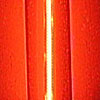-

-
Courses
Find courses by:
Collections
Cross-Disciplinary Topic Lists
- About
- Donate
- Featured Sites

 |
|
By the end of this lecture, you should:
› View/hide answer
As light goes out at an angle θ from the axis, it strikes the screen at a point \(0.10\sin \theta \) m from the center of the screen. The first minimum occurs when \[\sin \theta = \frac{\lambda }{D} = \frac{{500 \times {{10}^{ - 9}}}}{{100 \times {{10}^{ - 6}}}} = 5 \times {10^{ - 3}}\] The half width is then \(0.10\sin \theta = 5 \times {10^{ - 4}}\)m or 0.5 mm. The total width of the maximum is thus 1 mm, much wider than the slit.
› View/hide answer
For the CD, if the screen was 30 cm away, then the distance from the center was \(0.30\sin \theta \) m away. When \(\sin \theta =\frac{\lambda }{d}\), a bright maximum is seen.. Here \[\sin \theta = \frac{{14}}{{\sqrt {{{14}^2} + {{30}^2}} }} = 0.4229\] so \[d = \frac{{650 \times {{10}^{ - 9}}}}{{0.4229}} = 1.54 \times {10^{ - 6}}m\] or about 1.5~\mu m. For the DVD, the scale on the screen 20 cm away was \(0.20\sin \theta \). Similarly, \[\sin \theta = \frac{{43}}{{\sqrt {{{43}^2} + {{20}^2}} }} = 0.9067\] and \[d = \frac{{650 \times {{10}^{ - 9}}}}{{0.9067}} = 7.2 \times {10^{ - 7}}m\] or about 0.7~\mu m. We can manufacture such small dimensions routinely, and optical measurement is useful at these scales. Finally, note that the above conditions apply for one wavelength of light. In white light, many wavelengths are present so the interference conditions differ for each. This means some colors will interfere destructively while others at the same angle interfere constructively. Thus, colored bands will arise.
› View/hide answer
In a long, skinny triangle like that made by the distance to 61 Cygni and the separation presumed to be at right angles to that distance, the angle in radians is simply the separation divided by the distance. 180º is π radians so 24 is \[\frac{{24}}{{60 \times 60 \times 180}}\pi = 1.2 \times {10^{ - 4}}rad\] If this angle is multiplied by the distance, that is the physical separation. One light year is the distance light travels in a year, so 10 light years is approximately \(10 \times 3 \times {10^8} \times 60 \times 60 \times 24 \times 365 = 9.5 \times {10^{16}}\)m . The physical separation is then \(9.5 \times {10^{16}} \times 1.2 \times {10^{ - 4}} = 1.1 \times {10^{13}}\)m. As is often the case in astronomy, this big number is hard to grasp. Earth is about 150 million km from the Sun or \(1.5 \times {10^11}\)m. This is roughly 100 times that distance. Finally, what diameter of telescope is needed to separate them? The Rayleigh criterion gives the angle in radians, so we need \[1.2 \times {10^{ - 4}} = 1.2\frac{\lambda }{D}\] where we can take λ = 500 nm and solve for \[D = 1.2\frac{{500 \times {{10}^{ - 9}}}}{{1.2 \times {{10}^{ - 4}}}} = 5 \times {10^{ - 3}}m\] This is about the diameter of the eye pupil, and indeed the angular separation is about that mentioned in the lecture as the theoretical limit for the eye. In practice, small binoculars would be needed both to resolve the stars and to make them bright enough to see well.